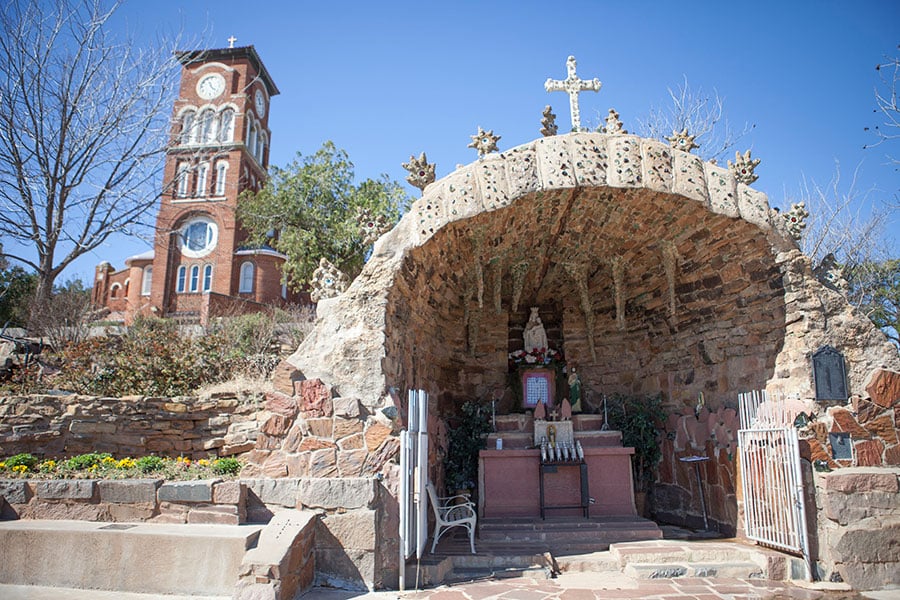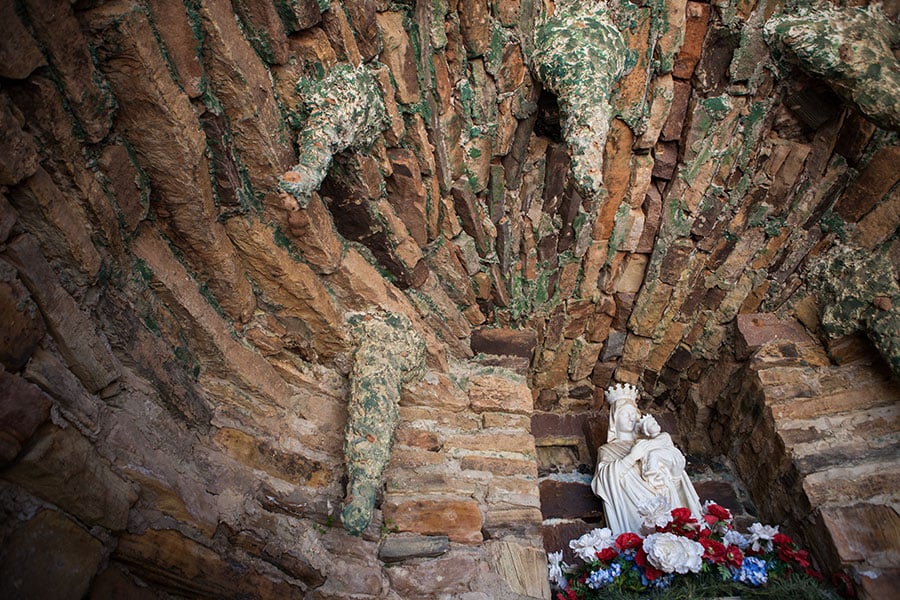The story of a grotto, a small town, and the intercession of Our Lady

The 30-foot by 20-foot Marian grotto at St. Mary Church in Windthorst was built in 1949 and receives visitors from all over the world. (NTC photo/Juan Guajardo)
WINDTHORST — Driving on Hwy. 281 through Windthorst, motorists can’t help but notice St. Mary Church towering on a hill after seeing miles of flat green pastures dotted with black and white dairy cows.
But what they can’t see from the road is St. Mary’s Grotto.
The grotto, also known as the shrine of “Our Lady of Highway 281,” is nestled on the bottom of the hill in front of the church. The grotto is a testament to a small town’s faith that God would return their men safely to them after World War II and is now also a memorial for Windthorst’s military veterans.
“I look at it as a spiritual and patriotic symbol of the Windthorst community’s appreciation for service members, and the role that religious faith plays in all our lives,” said David Teichman, of Scotland-Windthorst Veterans of Foreign Wars Post 2676. “To me, it’s a dual symbol — spiritual and patriotic, and it just shows that this community values that.”
The story of St. Mary’s Grotto is also connected to a small grotto built by parishioner Charles Lindemann after the death of his wife and mother of their 13 children in 1941, according to a history written by his son, the late Rusty Lindemann.
The small Marian grotto that Charles Lindemann built with Windthorst rock was dedicated on Dec. 7, 1941. After blessing the grotto, Father Francis Zimmerer, OSB — the pastor at the time — announced that he heard on the radio that Japan had bombed Pearl Harbor, Rusty Lindemann wrote.
Many Windthorst men — amounting to about 20 percent of the rural town’s population — were called to service or volunteered after that, including Fr. Zimmerer, who served as a chaplain. Meanwhile, the Young Ladies Society looked after the small grotto, kept flowers on it, and prayed to Our Lady of Perpetual Help to “protect their husbands, brothers, and boyfriends and bring them home safely.”
Rusty Lindemann also wrote that Fr. Zimmerer started a fund to build a 30-foot-wide by 20-foot-tall grotto once all the Windthorst men returned from World War II safely. A history by St. Mary Church said each serviceman regularly sent home part of his military pay to be used for the grotto.

Miraculously, all 64 Windthorst men returned, with only four injured.
Construction on the large grotto began in early 1949 and was completed in mid-1950. A formal dedication on Aug. 22, 1950 saw all 64 veterans in attendance. A plaque at the grotto displays all the names of the servicemen who helped pay for the grotto and who served in the armed forces during this time. “Their prayers were answered,” is written on a plaque in the shrine.
The shape and stone in the small grotto has a similar look to the big grotto, but the statues differ. Inside the small grotto is the Immaculate Conception, while the large grotto houses Our Lady of Perpetual Help.
The grotto is made of stone and granite from the Wichita Mountains 96 miles north of Windthorst near Lawton, Oklahoma. The Our Lady of Perpetual Help statue in the center of the altar was imported from Italy. It is five feet high and weighs 1,600 pounds.
In 2010, Scotland-Windthorst Veterans of Foreign Wars Post 2676 assumed care of major repairs and projects at St. Mary’s Grotto from the St. Joseph Society of St. Mary Parish, Teichman said. Parishioner Barbara Hoff helps take care of the flower beds at the grotto.
On Memorial Day 2014, a Veterans Memorial Wall topped with memorial bricks was dedicated. People were given the opportunity to buy bricks and have them engraved with the name, branch, and dates of service of military veterans buried in St. Mary’s Cemetery.
“It’s really special to me to keep all the veterans [legacies] alive,” said Bill Veith, who has been the commander of the Scotland-Windthorst VFW Post for 12 years. Every year the Scotland-Windthorst VFW has a ceremony to honor veterans at the grotto.
In a notebook inside the grotto, people can sign their names and prayer intentions when they visit.
Veith said people from all over the world have visited the grotto and memorial wall over the years.
Windthorst resident Dusty Sternadel said people often pray at the grotto and light votive candles in front of the altar for people’s special intentions. She and her husband, Brandon, have been taking their children to the grotto an hour before Mass every Sunday for several years.
“We talk, pray, laugh, and ultimately are all getting prepared for Mass. It helps the kids settle down before Mass and be prepared for the presence of Christ,” Sternadel said. “The grotto has a lot of great memories for pretty much everyone in town.”
